Nursing Essay: Analysis of a Clinical Case Study in Nursing
VerifiedAdded on 2023/01/05
|8
|3773
|62
Essay
AI Summary
This essay critically analyzes a nursing case study of a patient who underwent a laparoscopic cholecystectomy and experienced complications, including abdominal pain and sepsis. The essay explores the application of the Tanner Clinical Judgment Model to assess the issues in the case, such as misdiagnosis, communication failures between departments, and delayed patient care. The analysis focuses on the importance of clinical assessment, effective communication, and multidisciplinary care in improving patient outcomes. The essay discusses the importance of early detection of complications, thorough patient evaluation, and the implementation of integrated healthcare strategies to prevent adverse events and enhance patient satisfaction. The case highlights the need for hospitals to adopt IT-based solutions for seamless information sharing and improved patient management.
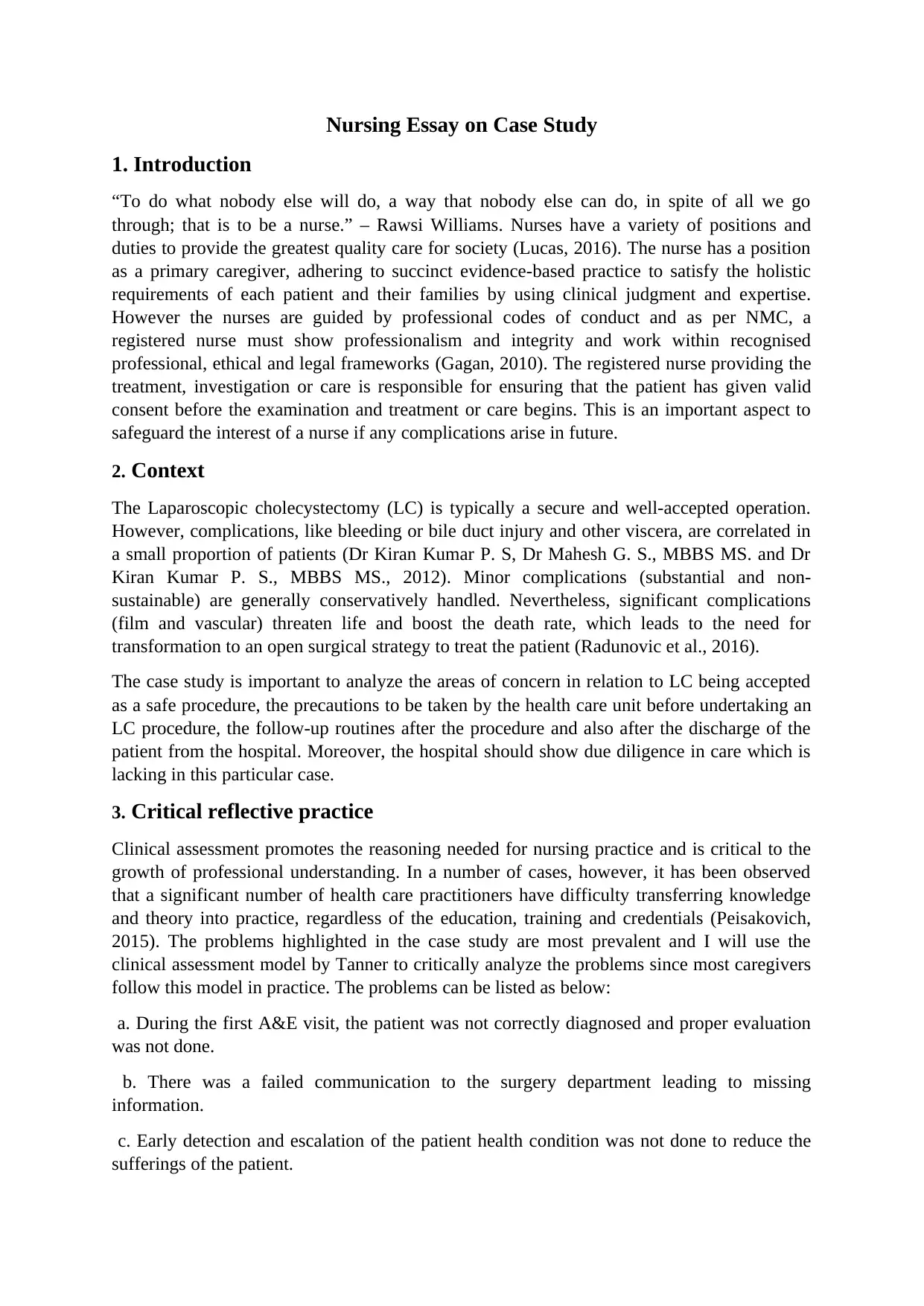
Nursing Essay on Case Study
1. Introduction
“To do what nobody else will do, a way that nobody else can do, in spite of all we go
through; that is to be a nurse.” – Rawsi Williams. Nurses have a variety of positions and
duties to provide the greatest quality care for society (Lucas, 2016). The nurse has a position
as a primary caregiver, adhering to succinct evidence-based practice to satisfy the holistic
requirements of each patient and their families by using clinical judgment and expertise.
However the nurses are guided by professional codes of conduct and as per NMC, a
registered nurse must show professionalism and integrity and work within recognised
professional, ethical and legal frameworks (Gagan, 2010). The registered nurse providing the
treatment, investigation or care is responsible for ensuring that the patient has given valid
consent before the examination and treatment or care begins. This is an important aspect to
safeguard the interest of a nurse if any complications arise in future.
2. Context
The Laparoscopic cholecystectomy (LC) is typically a secure and well-accepted operation.
However, complications, like bleeding or bile duct injury and other viscera, are correlated in
a small proportion of patients (Dr Kiran Kumar P. S, Dr Mahesh G. S., MBBS MS. and Dr
Kiran Kumar P. S., MBBS MS., 2012). Minor complications (substantial and non-
sustainable) are generally conservatively handled. Nevertheless, significant complications
(film and vascular) threaten life and boost the death rate, which leads to the need for
transformation to an open surgical strategy to treat the patient (Radunovic et al., 2016).
The case study is important to analyze the areas of concern in relation to LC being accepted
as a safe procedure, the precautions to be taken by the health care unit before undertaking an
LC procedure, the follow-up routines after the procedure and also after the discharge of the
patient from the hospital. Moreover, the hospital should show due diligence in care which is
lacking in this particular case.
3. Critical reflective practice
Clinical assessment promotes the reasoning needed for nursing practice and is critical to the
growth of professional understanding. In a number of cases, however, it has been observed
that a significant number of health care practitioners have difficulty transferring knowledge
and theory into practice, regardless of the education, training and credentials (Peisakovich,
2015). The problems highlighted in the case study are most prevalent and I will use the
clinical assessment model by Tanner to critically analyze the problems since most caregivers
follow this model in practice. The problems can be listed as below:
a. During the first A&E visit, the patient was not correctly diagnosed and proper evaluation
was not done.
b. There was a failed communication to the surgery department leading to missing
information.
c. Early detection and escalation of the patient health condition was not done to reduce the
sufferings of the patient.
1. Introduction
“To do what nobody else will do, a way that nobody else can do, in spite of all we go
through; that is to be a nurse.” – Rawsi Williams. Nurses have a variety of positions and
duties to provide the greatest quality care for society (Lucas, 2016). The nurse has a position
as a primary caregiver, adhering to succinct evidence-based practice to satisfy the holistic
requirements of each patient and their families by using clinical judgment and expertise.
However the nurses are guided by professional codes of conduct and as per NMC, a
registered nurse must show professionalism and integrity and work within recognised
professional, ethical and legal frameworks (Gagan, 2010). The registered nurse providing the
treatment, investigation or care is responsible for ensuring that the patient has given valid
consent before the examination and treatment or care begins. This is an important aspect to
safeguard the interest of a nurse if any complications arise in future.
2. Context
The Laparoscopic cholecystectomy (LC) is typically a secure and well-accepted operation.
However, complications, like bleeding or bile duct injury and other viscera, are correlated in
a small proportion of patients (Dr Kiran Kumar P. S, Dr Mahesh G. S., MBBS MS. and Dr
Kiran Kumar P. S., MBBS MS., 2012). Minor complications (substantial and non-
sustainable) are generally conservatively handled. Nevertheless, significant complications
(film and vascular) threaten life and boost the death rate, which leads to the need for
transformation to an open surgical strategy to treat the patient (Radunovic et al., 2016).
The case study is important to analyze the areas of concern in relation to LC being accepted
as a safe procedure, the precautions to be taken by the health care unit before undertaking an
LC procedure, the follow-up routines after the procedure and also after the discharge of the
patient from the hospital. Moreover, the hospital should show due diligence in care which is
lacking in this particular case.
3. Critical reflective practice
Clinical assessment promotes the reasoning needed for nursing practice and is critical to the
growth of professional understanding. In a number of cases, however, it has been observed
that a significant number of health care practitioners have difficulty transferring knowledge
and theory into practice, regardless of the education, training and credentials (Peisakovich,
2015). The problems highlighted in the case study are most prevalent and I will use the
clinical assessment model by Tanner to critically analyze the problems since most caregivers
follow this model in practice. The problems can be listed as below:
a. During the first A&E visit, the patient was not correctly diagnosed and proper evaluation
was not done.
b. There was a failed communication to the surgery department leading to missing
information.
c. Early detection and escalation of the patient health condition was not done to reduce the
sufferings of the patient.
Paraphrase This Document
Need a fresh take? Get an instant paraphrase of this document with our AI Paraphraser
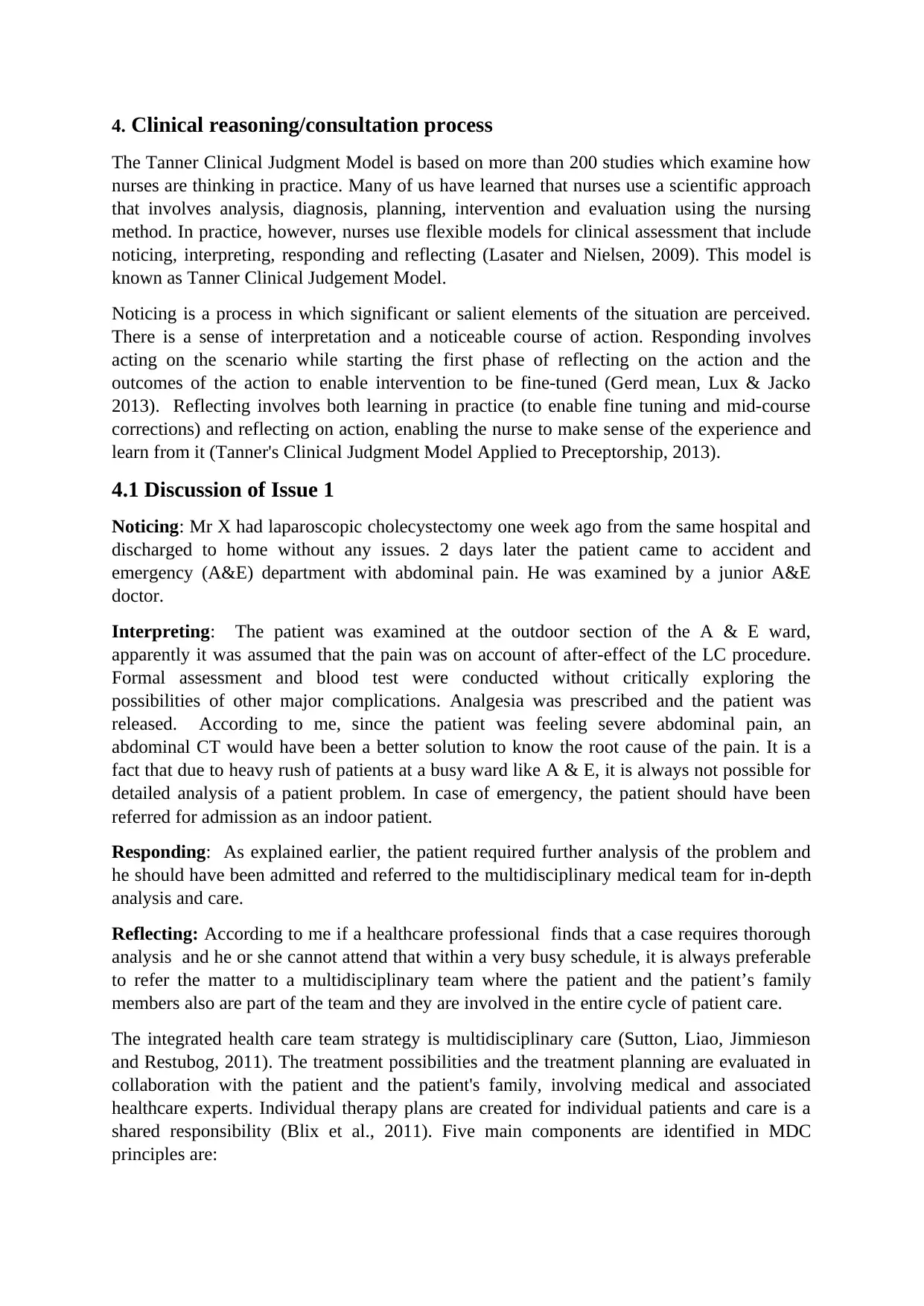
4. Clinical reasoning/consultation process
The Tanner Clinical Judgment Model is based on more than 200 studies which examine how
nurses are thinking in practice. Many of us have learned that nurses use a scientific approach
that involves analysis, diagnosis, planning, intervention and evaluation using the nursing
method. In practice, however, nurses use flexible models for clinical assessment that include
noticing, interpreting, responding and reflecting (Lasater and Nielsen, 2009). This model is
known as Tanner Clinical Judgement Model.
Noticing is a process in which significant or salient elements of the situation are perceived.
There is a sense of interpretation and a noticeable course of action. Responding involves
acting on the scenario while starting the first phase of reflecting on the action and the
outcomes of the action to enable intervention to be fine-tuned (Gerd mean, Lux & Jacko
2013). Reflecting involves both learning in practice (to enable fine tuning and mid-course
corrections) and reflecting on action, enabling the nurse to make sense of the experience and
learn from it (Tanner's Clinical Judgment Model Applied to Preceptorship, 2013).
4.1 Discussion of Issue 1
Noticing: Mr X had laparoscopic cholecystectomy one week ago from the same hospital and
discharged to home without any issues. 2 days later the patient came to accident and
emergency (A&E) department with abdominal pain. He was examined by a junior A&E
doctor.
Interpreting: The patient was examined at the outdoor section of the A & E ward,
apparently it was assumed that the pain was on account of after-effect of the LC procedure.
Formal assessment and blood test were conducted without critically exploring the
possibilities of other major complications. Analgesia was prescribed and the patient was
released. According to me, since the patient was feeling severe abdominal pain, an
abdominal CT would have been a better solution to know the root cause of the pain. It is a
fact that due to heavy rush of patients at a busy ward like A & E, it is always not possible for
detailed analysis of a patient problem. In case of emergency, the patient should have been
referred for admission as an indoor patient.
Responding: As explained earlier, the patient required further analysis of the problem and
he should have been admitted and referred to the multidisciplinary medical team for in-depth
analysis and care.
Reflecting: According to me if a healthcare professional finds that a case requires thorough
analysis and he or she cannot attend that within a very busy schedule, it is always preferable
to refer the matter to a multidisciplinary team where the patient and the patient’s family
members also are part of the team and they are involved in the entire cycle of patient care.
The integrated health care team strategy is multidisciplinary care (Sutton, Liao, Jimmieson
and Restubog, 2011). The treatment possibilities and the treatment planning are evaluated in
collaboration with the patient and the patient's family, involving medical and associated
healthcare experts. Individual therapy plans are created for individual patients and care is a
shared responsibility (Blix et al., 2011). Five main components are identified in MDC
principles are:
The Tanner Clinical Judgment Model is based on more than 200 studies which examine how
nurses are thinking in practice. Many of us have learned that nurses use a scientific approach
that involves analysis, diagnosis, planning, intervention and evaluation using the nursing
method. In practice, however, nurses use flexible models for clinical assessment that include
noticing, interpreting, responding and reflecting (Lasater and Nielsen, 2009). This model is
known as Tanner Clinical Judgement Model.
Noticing is a process in which significant or salient elements of the situation are perceived.
There is a sense of interpretation and a noticeable course of action. Responding involves
acting on the scenario while starting the first phase of reflecting on the action and the
outcomes of the action to enable intervention to be fine-tuned (Gerd mean, Lux & Jacko
2013). Reflecting involves both learning in practice (to enable fine tuning and mid-course
corrections) and reflecting on action, enabling the nurse to make sense of the experience and
learn from it (Tanner's Clinical Judgment Model Applied to Preceptorship, 2013).
4.1 Discussion of Issue 1
Noticing: Mr X had laparoscopic cholecystectomy one week ago from the same hospital and
discharged to home without any issues. 2 days later the patient came to accident and
emergency (A&E) department with abdominal pain. He was examined by a junior A&E
doctor.
Interpreting: The patient was examined at the outdoor section of the A & E ward,
apparently it was assumed that the pain was on account of after-effect of the LC procedure.
Formal assessment and blood test were conducted without critically exploring the
possibilities of other major complications. Analgesia was prescribed and the patient was
released. According to me, since the patient was feeling severe abdominal pain, an
abdominal CT would have been a better solution to know the root cause of the pain. It is a
fact that due to heavy rush of patients at a busy ward like A & E, it is always not possible for
detailed analysis of a patient problem. In case of emergency, the patient should have been
referred for admission as an indoor patient.
Responding: As explained earlier, the patient required further analysis of the problem and
he should have been admitted and referred to the multidisciplinary medical team for in-depth
analysis and care.
Reflecting: According to me if a healthcare professional finds that a case requires thorough
analysis and he or she cannot attend that within a very busy schedule, it is always preferable
to refer the matter to a multidisciplinary team where the patient and the patient’s family
members also are part of the team and they are involved in the entire cycle of patient care.
The integrated health care team strategy is multidisciplinary care (Sutton, Liao, Jimmieson
and Restubog, 2011). The treatment possibilities and the treatment planning are evaluated in
collaboration with the patient and the patient's family, involving medical and associated
healthcare experts. Individual therapy plans are created for individual patients and care is a
shared responsibility (Blix et al., 2011). Five main components are identified in MDC
principles are:
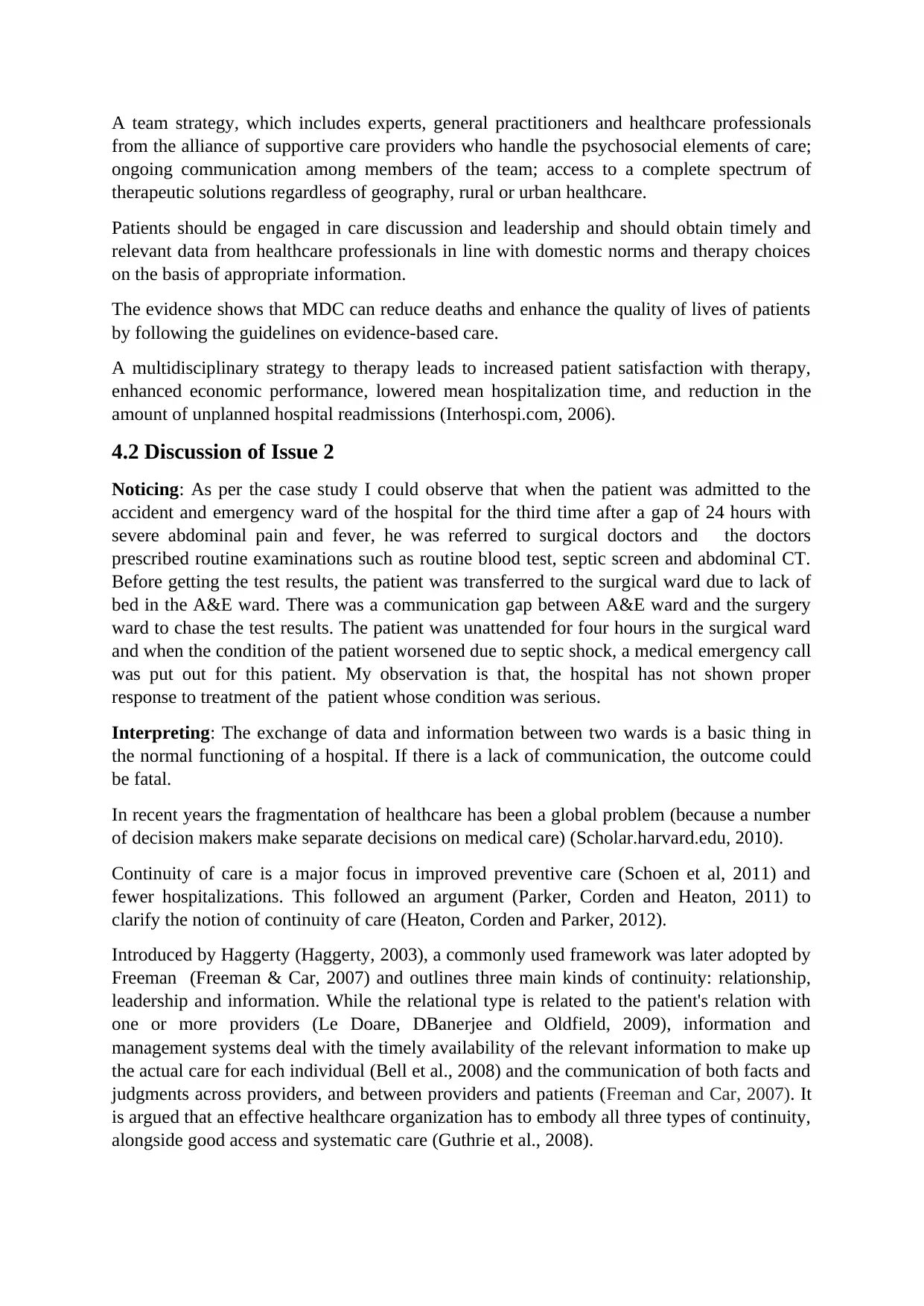
A team strategy, which includes experts, general practitioners and healthcare professionals
from the alliance of supportive care providers who handle the psychosocial elements of care;
ongoing communication among members of the team; access to a complete spectrum of
therapeutic solutions regardless of geography, rural or urban healthcare.
Patients should be engaged in care discussion and leadership and should obtain timely and
relevant data from healthcare professionals in line with domestic norms and therapy choices
on the basis of appropriate information.
The evidence shows that MDC can reduce deaths and enhance the quality of lives of patients
by following the guidelines on evidence-based care.
A multidisciplinary strategy to therapy leads to increased patient satisfaction with therapy,
enhanced economic performance, lowered mean hospitalization time, and reduction in the
amount of unplanned hospital readmissions (Interhospi.com, 2006).
4.2 Discussion of Issue 2
Noticing: As per the case study I could observe that when the patient was admitted to the
accident and emergency ward of the hospital for the third time after a gap of 24 hours with
severe abdominal pain and fever, he was referred to surgical doctors and the doctors
prescribed routine examinations such as routine blood test, septic screen and abdominal CT.
Before getting the test results, the patient was transferred to the surgical ward due to lack of
bed in the A&E ward. There was a communication gap between A&E ward and the surgery
ward to chase the test results. The patient was unattended for four hours in the surgical ward
and when the condition of the patient worsened due to septic shock, a medical emergency call
was put out for this patient. My observation is that, the hospital has not shown proper
response to treatment of the patient whose condition was serious.
Interpreting: The exchange of data and information between two wards is a basic thing in
the normal functioning of a hospital. If there is a lack of communication, the outcome could
be fatal.
In recent years the fragmentation of healthcare has been a global problem (because a number
of decision makers make separate decisions on medical care) (Scholar.harvard.edu, 2010).
Continuity of care is a major focus in improved preventive care (Schoen et al, 2011) and
fewer hospitalizations. This followed an argument (Parker, Corden and Heaton, 2011) to
clarify the notion of continuity of care (Heaton, Corden and Parker, 2012).
Introduced by Haggerty (Haggerty, 2003), a commonly used framework was later adopted by
Freeman (Freeman & Car, 2007) and outlines three main kinds of continuity: relationship,
leadership and information. While the relational type is related to the patient's relation with
one or more providers (Le Doare, DBanerjee and Oldfield, 2009), information and
management systems deal with the timely availability of the relevant information to make up
the actual care for each individual (Bell et al., 2008) and the communication of both facts and
judgments across providers, and between providers and patients (Freeman and Car, 2007). It
is argued that an effective healthcare organization has to embody all three types of continuity,
alongside good access and systematic care (Guthrie et al., 2008).
from the alliance of supportive care providers who handle the psychosocial elements of care;
ongoing communication among members of the team; access to a complete spectrum of
therapeutic solutions regardless of geography, rural or urban healthcare.
Patients should be engaged in care discussion and leadership and should obtain timely and
relevant data from healthcare professionals in line with domestic norms and therapy choices
on the basis of appropriate information.
The evidence shows that MDC can reduce deaths and enhance the quality of lives of patients
by following the guidelines on evidence-based care.
A multidisciplinary strategy to therapy leads to increased patient satisfaction with therapy,
enhanced economic performance, lowered mean hospitalization time, and reduction in the
amount of unplanned hospital readmissions (Interhospi.com, 2006).
4.2 Discussion of Issue 2
Noticing: As per the case study I could observe that when the patient was admitted to the
accident and emergency ward of the hospital for the third time after a gap of 24 hours with
severe abdominal pain and fever, he was referred to surgical doctors and the doctors
prescribed routine examinations such as routine blood test, septic screen and abdominal CT.
Before getting the test results, the patient was transferred to the surgical ward due to lack of
bed in the A&E ward. There was a communication gap between A&E ward and the surgery
ward to chase the test results. The patient was unattended for four hours in the surgical ward
and when the condition of the patient worsened due to septic shock, a medical emergency call
was put out for this patient. My observation is that, the hospital has not shown proper
response to treatment of the patient whose condition was serious.
Interpreting: The exchange of data and information between two wards is a basic thing in
the normal functioning of a hospital. If there is a lack of communication, the outcome could
be fatal.
In recent years the fragmentation of healthcare has been a global problem (because a number
of decision makers make separate decisions on medical care) (Scholar.harvard.edu, 2010).
Continuity of care is a major focus in improved preventive care (Schoen et al, 2011) and
fewer hospitalizations. This followed an argument (Parker, Corden and Heaton, 2011) to
clarify the notion of continuity of care (Heaton, Corden and Parker, 2012).
Introduced by Haggerty (Haggerty, 2003), a commonly used framework was later adopted by
Freeman (Freeman & Car, 2007) and outlines three main kinds of continuity: relationship,
leadership and information. While the relational type is related to the patient's relation with
one or more providers (Le Doare, DBanerjee and Oldfield, 2009), information and
management systems deal with the timely availability of the relevant information to make up
the actual care for each individual (Bell et al., 2008) and the communication of both facts and
judgments across providers, and between providers and patients (Freeman and Car, 2007). It
is argued that an effective healthcare organization has to embody all three types of continuity,
alongside good access and systematic care (Guthrie et al., 2008).
⊘ This is a preview!⊘
Do you want full access?
Subscribe today to unlock all pages.

Trusted by 1+ million students worldwide
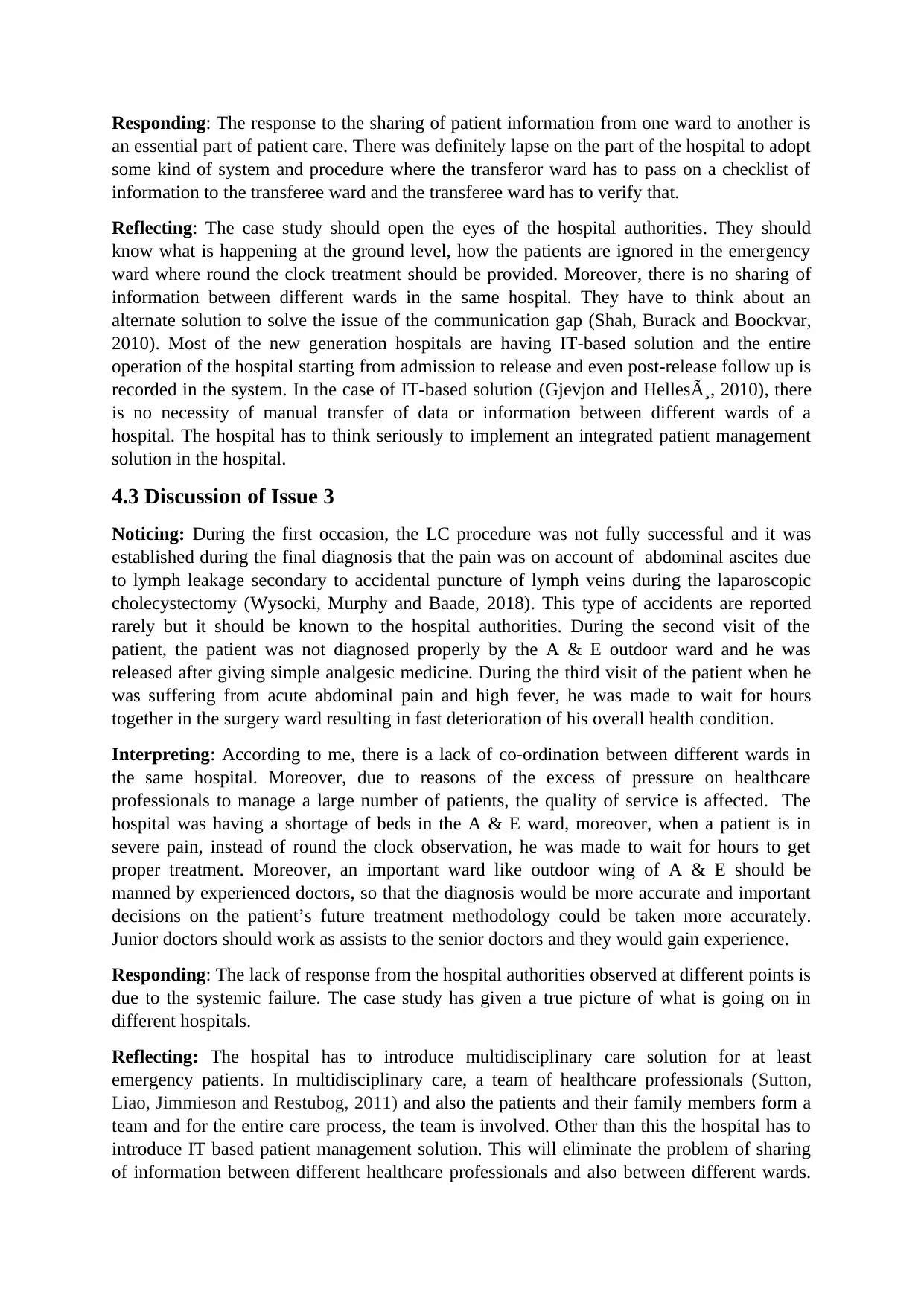
Responding: The response to the sharing of patient information from one ward to another is
an essential part of patient care. There was definitely lapse on the part of the hospital to adopt
some kind of system and procedure where the transferor ward has to pass on a checklist of
information to the transferee ward and the transferee ward has to verify that.
Reflecting: The case study should open the eyes of the hospital authorities. They should
know what is happening at the ground level, how the patients are ignored in the emergency
ward where round the clock treatment should be provided. Moreover, there is no sharing of
information between different wards in the same hospital. They have to think about an
alternate solution to solve the issue of the communication gap (Shah, Burack and Boockvar,
2010). Most of the new generation hospitals are having IT-based solution and the entire
operation of the hospital starting from admission to release and even post-release follow up is
recorded in the system. In the case of IT-based solution (Gjevjon and Hellesø, 2010), there
is no necessity of manual transfer of data or information between different wards of a
hospital. The hospital has to think seriously to implement an integrated patient management
solution in the hospital.
4.3 Discussion of Issue 3
Noticing: During the first occasion, the LC procedure was not fully successful and it was
established during the final diagnosis that the pain was on account of abdominal ascites due
to lymph leakage secondary to accidental puncture of lymph veins during the laparoscopic
cholecystectomy (Wysocki, Murphy and Baade, 2018). This type of accidents are reported
rarely but it should be known to the hospital authorities. During the second visit of the
patient, the patient was not diagnosed properly by the A & E outdoor ward and he was
released after giving simple analgesic medicine. During the third visit of the patient when he
was suffering from acute abdominal pain and high fever, he was made to wait for hours
together in the surgery ward resulting in fast deterioration of his overall health condition.
Interpreting: According to me, there is a lack of co-ordination between different wards in
the same hospital. Moreover, due to reasons of the excess of pressure on healthcare
professionals to manage a large number of patients, the quality of service is affected. The
hospital was having a shortage of beds in the A & E ward, moreover, when a patient is in
severe pain, instead of round the clock observation, he was made to wait for hours to get
proper treatment. Moreover, an important ward like outdoor wing of A & E should be
manned by experienced doctors, so that the diagnosis would be more accurate and important
decisions on the patient’s future treatment methodology could be taken more accurately.
Junior doctors should work as assists to the senior doctors and they would gain experience.
Responding: The lack of response from the hospital authorities observed at different points is
due to the systemic failure. The case study has given a true picture of what is going on in
different hospitals.
Reflecting: The hospital has to introduce multidisciplinary care solution for at least
emergency patients. In multidisciplinary care, a team of healthcare professionals (Sutton,
Liao, Jimmieson and Restubog, 2011) and also the patients and their family members form a
team and for the entire care process, the team is involved. Other than this the hospital has to
introduce IT based patient management solution. This will eliminate the problem of sharing
of information between different healthcare professionals and also between different wards.
an essential part of patient care. There was definitely lapse on the part of the hospital to adopt
some kind of system and procedure where the transferor ward has to pass on a checklist of
information to the transferee ward and the transferee ward has to verify that.
Reflecting: The case study should open the eyes of the hospital authorities. They should
know what is happening at the ground level, how the patients are ignored in the emergency
ward where round the clock treatment should be provided. Moreover, there is no sharing of
information between different wards in the same hospital. They have to think about an
alternate solution to solve the issue of the communication gap (Shah, Burack and Boockvar,
2010). Most of the new generation hospitals are having IT-based solution and the entire
operation of the hospital starting from admission to release and even post-release follow up is
recorded in the system. In the case of IT-based solution (Gjevjon and Hellesø, 2010), there
is no necessity of manual transfer of data or information between different wards of a
hospital. The hospital has to think seriously to implement an integrated patient management
solution in the hospital.
4.3 Discussion of Issue 3
Noticing: During the first occasion, the LC procedure was not fully successful and it was
established during the final diagnosis that the pain was on account of abdominal ascites due
to lymph leakage secondary to accidental puncture of lymph veins during the laparoscopic
cholecystectomy (Wysocki, Murphy and Baade, 2018). This type of accidents are reported
rarely but it should be known to the hospital authorities. During the second visit of the
patient, the patient was not diagnosed properly by the A & E outdoor ward and he was
released after giving simple analgesic medicine. During the third visit of the patient when he
was suffering from acute abdominal pain and high fever, he was made to wait for hours
together in the surgery ward resulting in fast deterioration of his overall health condition.
Interpreting: According to me, there is a lack of co-ordination between different wards in
the same hospital. Moreover, due to reasons of the excess of pressure on healthcare
professionals to manage a large number of patients, the quality of service is affected. The
hospital was having a shortage of beds in the A & E ward, moreover, when a patient is in
severe pain, instead of round the clock observation, he was made to wait for hours to get
proper treatment. Moreover, an important ward like outdoor wing of A & E should be
manned by experienced doctors, so that the diagnosis would be more accurate and important
decisions on the patient’s future treatment methodology could be taken more accurately.
Junior doctors should work as assists to the senior doctors and they would gain experience.
Responding: The lack of response from the hospital authorities observed at different points is
due to the systemic failure. The case study has given a true picture of what is going on in
different hospitals.
Reflecting: The hospital has to introduce multidisciplinary care solution for at least
emergency patients. In multidisciplinary care, a team of healthcare professionals (Sutton,
Liao, Jimmieson and Restubog, 2011) and also the patients and their family members form a
team and for the entire care process, the team is involved. Other than this the hospital has to
introduce IT based patient management solution. This will eliminate the problem of sharing
of information between different healthcare professionals and also between different wards.
Paraphrase This Document
Need a fresh take? Get an instant paraphrase of this document with our AI Paraphraser
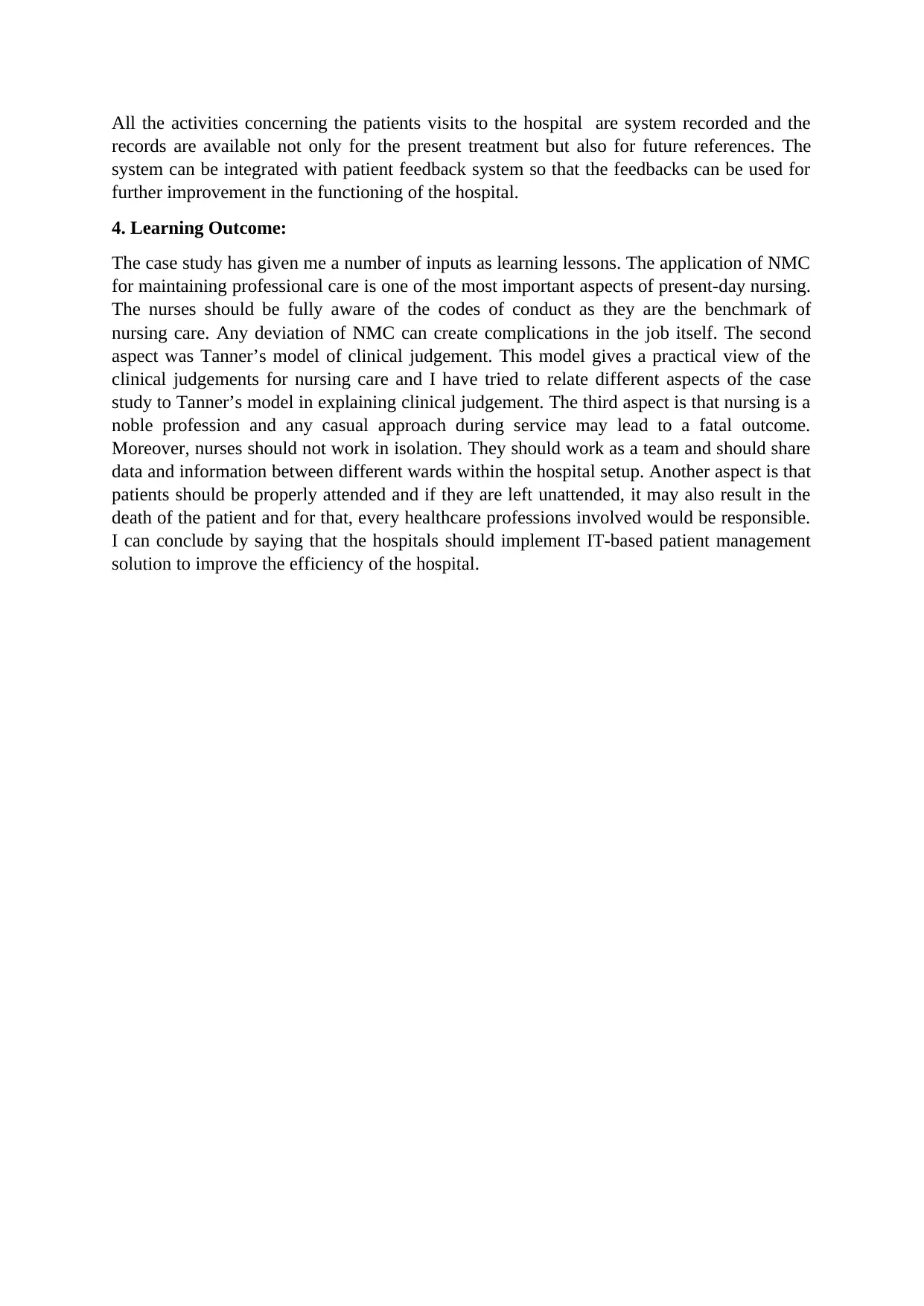
All the activities concerning the patients visits to the hospital are system recorded and the
records are available not only for the present treatment but also for future references. The
system can be integrated with patient feedback system so that the feedbacks can be used for
further improvement in the functioning of the hospital.
4. Learning Outcome:
The case study has given me a number of inputs as learning lessons. The application of NMC
for maintaining professional care is one of the most important aspects of present-day nursing.
The nurses should be fully aware of the codes of conduct as they are the benchmark of
nursing care. Any deviation of NMC can create complications in the job itself. The second
aspect was Tanner’s model of clinical judgement. This model gives a practical view of the
clinical judgements for nursing care and I have tried to relate different aspects of the case
study to Tanner’s model in explaining clinical judgement. The third aspect is that nursing is a
noble profession and any casual approach during service may lead to a fatal outcome.
Moreover, nurses should not work in isolation. They should work as a team and should share
data and information between different wards within the hospital setup. Another aspect is that
patients should be properly attended and if they are left unattended, it may also result in the
death of the patient and for that, every healthcare professions involved would be responsible.
I can conclude by saying that the hospitals should implement IT-based patient management
solution to improve the efficiency of the hospital.
records are available not only for the present treatment but also for future references. The
system can be integrated with patient feedback system so that the feedbacks can be used for
further improvement in the functioning of the hospital.
4. Learning Outcome:
The case study has given me a number of inputs as learning lessons. The application of NMC
for maintaining professional care is one of the most important aspects of present-day nursing.
The nurses should be fully aware of the codes of conduct as they are the benchmark of
nursing care. Any deviation of NMC can create complications in the job itself. The second
aspect was Tanner’s model of clinical judgement. This model gives a practical view of the
clinical judgements for nursing care and I have tried to relate different aspects of the case
study to Tanner’s model in explaining clinical judgement. The third aspect is that nursing is a
noble profession and any casual approach during service may lead to a fatal outcome.
Moreover, nurses should not work in isolation. They should work as a team and should share
data and information between different wards within the hospital setup. Another aspect is that
patients should be properly attended and if they are left unattended, it may also result in the
death of the patient and for that, every healthcare professions involved would be responsible.
I can conclude by saying that the hospitals should implement IT-based patient management
solution to improve the efficiency of the hospital.
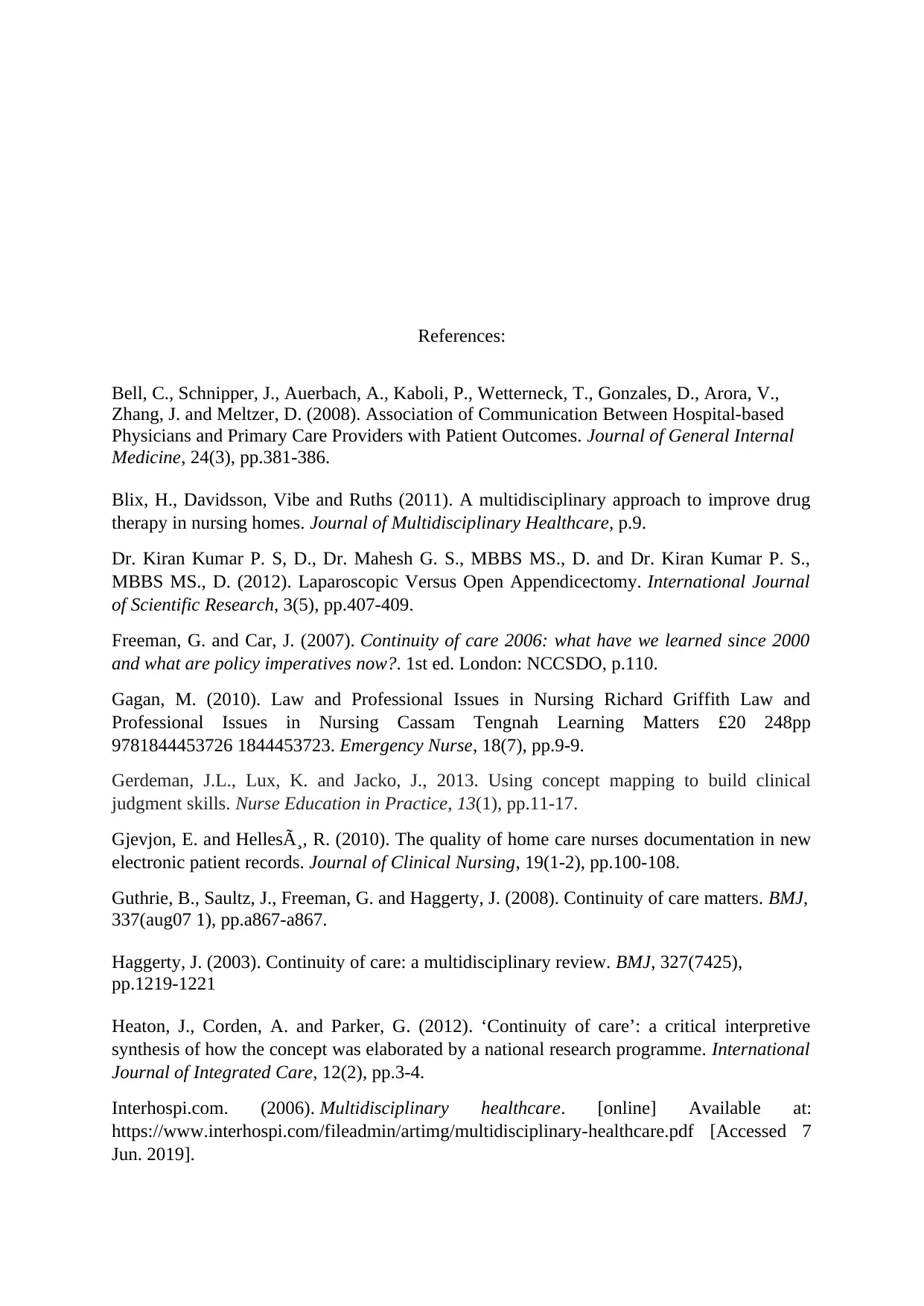
References:
Bell, C., Schnipper, J., Auerbach, A., Kaboli, P., Wetterneck, T., Gonzales, D., Arora, V.,
Zhang, J. and Meltzer, D. (2008). Association of Communication Between Hospital-based
Physicians and Primary Care Providers with Patient Outcomes. Journal of General Internal
Medicine, 24(3), pp.381-386.
Blix, H., Davidsson, Vibe and Ruths (2011). A multidisciplinary approach to improve drug
therapy in nursing homes. Journal of Multidisciplinary Healthcare, p.9.
Dr. Kiran Kumar P. S, D., Dr. Mahesh G. S., MBBS MS., D. and Dr. Kiran Kumar P. S.,
MBBS MS., D. (2012). Laparoscopic Versus Open Appendicectomy. International Journal
of Scientific Research, 3(5), pp.407-409.
Freeman, G. and Car, J. (2007). Continuity of care 2006: what have we learned since 2000
and what are policy imperatives now?. 1st ed. London: NCCSDO, p.110.
Gagan, M. (2010). Law and Professional Issues in Nursing Richard Griffith Law and
Professional Issues in Nursing Cassam Tengnah Learning Matters £20 248pp
9781844453726 1844453723. Emergency Nurse, 18(7), pp.9-9.
Gerdeman, J.L., Lux, K. and Jacko, J., 2013. Using concept mapping to build clinical
judgment skills. Nurse Education in Practice, 13(1), pp.11-17.
Gjevjon, E. and Hellesø, R. (2010). The quality of home care nurses documentation in new
electronic patient records. Journal of Clinical Nursing, 19(1-2), pp.100-108.
Guthrie, B., Saultz, J., Freeman, G. and Haggerty, J. (2008). Continuity of care matters. BMJ,
337(aug07 1), pp.a867-a867.
Haggerty, J. (2003). Continuity of care: a multidisciplinary review. BMJ, 327(7425),
pp.1219-1221
Heaton, J., Corden, A. and Parker, G. (2012). ‘Continuity of care’: a critical interpretive
synthesis of how the concept was elaborated by a national research programme. International
Journal of Integrated Care, 12(2), pp.3-4.
Interhospi.com. (2006). Multidisciplinary healthcare. [online] Available at:
https://www.interhospi.com/fileadmin/artimg/multidisciplinary-healthcare.pdf [Accessed 7
Jun. 2019].
Bell, C., Schnipper, J., Auerbach, A., Kaboli, P., Wetterneck, T., Gonzales, D., Arora, V.,
Zhang, J. and Meltzer, D. (2008). Association of Communication Between Hospital-based
Physicians and Primary Care Providers with Patient Outcomes. Journal of General Internal
Medicine, 24(3), pp.381-386.
Blix, H., Davidsson, Vibe and Ruths (2011). A multidisciplinary approach to improve drug
therapy in nursing homes. Journal of Multidisciplinary Healthcare, p.9.
Dr. Kiran Kumar P. S, D., Dr. Mahesh G. S., MBBS MS., D. and Dr. Kiran Kumar P. S.,
MBBS MS., D. (2012). Laparoscopic Versus Open Appendicectomy. International Journal
of Scientific Research, 3(5), pp.407-409.
Freeman, G. and Car, J. (2007). Continuity of care 2006: what have we learned since 2000
and what are policy imperatives now?. 1st ed. London: NCCSDO, p.110.
Gagan, M. (2010). Law and Professional Issues in Nursing Richard Griffith Law and
Professional Issues in Nursing Cassam Tengnah Learning Matters £20 248pp
9781844453726 1844453723. Emergency Nurse, 18(7), pp.9-9.
Gerdeman, J.L., Lux, K. and Jacko, J., 2013. Using concept mapping to build clinical
judgment skills. Nurse Education in Practice, 13(1), pp.11-17.
Gjevjon, E. and Hellesø, R. (2010). The quality of home care nurses documentation in new
electronic patient records. Journal of Clinical Nursing, 19(1-2), pp.100-108.
Guthrie, B., Saultz, J., Freeman, G. and Haggerty, J. (2008). Continuity of care matters. BMJ,
337(aug07 1), pp.a867-a867.
Haggerty, J. (2003). Continuity of care: a multidisciplinary review. BMJ, 327(7425),
pp.1219-1221
Heaton, J., Corden, A. and Parker, G. (2012). ‘Continuity of care’: a critical interpretive
synthesis of how the concept was elaborated by a national research programme. International
Journal of Integrated Care, 12(2), pp.3-4.
Interhospi.com. (2006). Multidisciplinary healthcare. [online] Available at:
https://www.interhospi.com/fileadmin/artimg/multidisciplinary-healthcare.pdf [Accessed 7
Jun. 2019].
⊘ This is a preview!⊘
Do you want full access?
Subscribe today to unlock all pages.

Trusted by 1+ million students worldwide
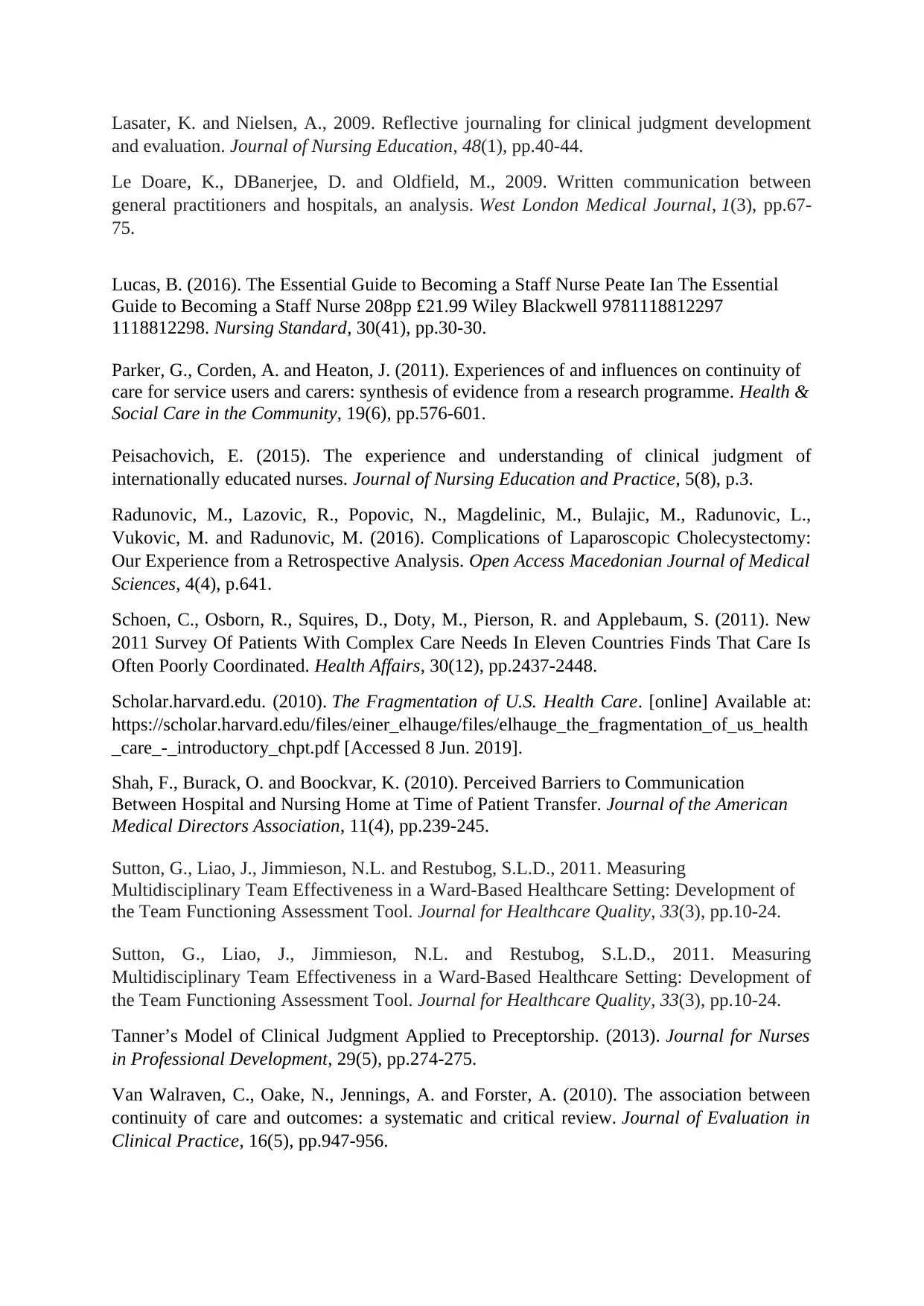
Lasater, K. and Nielsen, A., 2009. Reflective journaling for clinical judgment development
and evaluation. Journal of Nursing Education, 48(1), pp.40-44.
Le Doare, K., DBanerjee, D. and Oldfield, M., 2009. Written communication between
general practitioners and hospitals, an analysis. West London Medical Journal, 1(3), pp.67-
75.
Lucas, B. (2016). The Essential Guide to Becoming a Staff Nurse Peate Ian The Essential
Guide to Becoming a Staff Nurse 208pp £21.99 Wiley Blackwell 9781118812297
1118812298. Nursing Standard, 30(41), pp.30-30.
Parker, G., Corden, A. and Heaton, J. (2011). Experiences of and influences on continuity of
care for service users and carers: synthesis of evidence from a research programme. Health &
Social Care in the Community, 19(6), pp.576-601.
Peisachovich, E. (2015). The experience and understanding of clinical judgment of
internationally educated nurses. Journal of Nursing Education and Practice, 5(8), p.3.
Radunovic, M., Lazovic, R., Popovic, N., Magdelinic, M., Bulajic, M., Radunovic, L.,
Vukovic, M. and Radunovic, M. (2016). Complications of Laparoscopic Cholecystectomy:
Our Experience from a Retrospective Analysis. Open Access Macedonian Journal of Medical
Sciences, 4(4), p.641.
Schoen, C., Osborn, R., Squires, D., Doty, M., Pierson, R. and Applebaum, S. (2011). New
2011 Survey Of Patients With Complex Care Needs In Eleven Countries Finds That Care Is
Often Poorly Coordinated. Health Affairs, 30(12), pp.2437-2448.
Scholar.harvard.edu. (2010). The Fragmentation of U.S. Health Care. [online] Available at:
https://scholar.harvard.edu/files/einer_elhauge/files/elhauge_the_fragmentation_of_us_health
_care_-_introductory_chpt.pdf [Accessed 8 Jun. 2019].
Shah, F., Burack, O. and Boockvar, K. (2010). Perceived Barriers to Communication
Between Hospital and Nursing Home at Time of Patient Transfer. Journal of the American
Medical Directors Association, 11(4), pp.239-245.
Sutton, G., Liao, J., Jimmieson, N.L. and Restubog, S.L.D., 2011. Measuring
Multidisciplinary Team Effectiveness in a Ward‐Based Healthcare Setting: Development of
the Team Functioning Assessment Tool. Journal for Healthcare Quality, 33(3), pp.10-24.
Sutton, G., Liao, J., Jimmieson, N.L. and Restubog, S.L.D., 2011. Measuring
Multidisciplinary Team Effectiveness in a Ward‐Based Healthcare Setting: Development of
the Team Functioning Assessment Tool. Journal for Healthcare Quality, 33(3), pp.10-24.
Tanner’s Model of Clinical Judgment Applied to Preceptorship. (2013). Journal for Nurses
in Professional Development, 29(5), pp.274-275.
Van Walraven, C., Oake, N., Jennings, A. and Forster, A. (2010). The association between
continuity of care and outcomes: a systematic and critical review. Journal of Evaluation in
Clinical Practice, 16(5), pp.947-956.
and evaluation. Journal of Nursing Education, 48(1), pp.40-44.
Le Doare, K., DBanerjee, D. and Oldfield, M., 2009. Written communication between
general practitioners and hospitals, an analysis. West London Medical Journal, 1(3), pp.67-
75.
Lucas, B. (2016). The Essential Guide to Becoming a Staff Nurse Peate Ian The Essential
Guide to Becoming a Staff Nurse 208pp £21.99 Wiley Blackwell 9781118812297
1118812298. Nursing Standard, 30(41), pp.30-30.
Parker, G., Corden, A. and Heaton, J. (2011). Experiences of and influences on continuity of
care for service users and carers: synthesis of evidence from a research programme. Health &
Social Care in the Community, 19(6), pp.576-601.
Peisachovich, E. (2015). The experience and understanding of clinical judgment of
internationally educated nurses. Journal of Nursing Education and Practice, 5(8), p.3.
Radunovic, M., Lazovic, R., Popovic, N., Magdelinic, M., Bulajic, M., Radunovic, L.,
Vukovic, M. and Radunovic, M. (2016). Complications of Laparoscopic Cholecystectomy:
Our Experience from a Retrospective Analysis. Open Access Macedonian Journal of Medical
Sciences, 4(4), p.641.
Schoen, C., Osborn, R., Squires, D., Doty, M., Pierson, R. and Applebaum, S. (2011). New
2011 Survey Of Patients With Complex Care Needs In Eleven Countries Finds That Care Is
Often Poorly Coordinated. Health Affairs, 30(12), pp.2437-2448.
Scholar.harvard.edu. (2010). The Fragmentation of U.S. Health Care. [online] Available at:
https://scholar.harvard.edu/files/einer_elhauge/files/elhauge_the_fragmentation_of_us_health
_care_-_introductory_chpt.pdf [Accessed 8 Jun. 2019].
Shah, F., Burack, O. and Boockvar, K. (2010). Perceived Barriers to Communication
Between Hospital and Nursing Home at Time of Patient Transfer. Journal of the American
Medical Directors Association, 11(4), pp.239-245.
Sutton, G., Liao, J., Jimmieson, N.L. and Restubog, S.L.D., 2011. Measuring
Multidisciplinary Team Effectiveness in a Ward‐Based Healthcare Setting: Development of
the Team Functioning Assessment Tool. Journal for Healthcare Quality, 33(3), pp.10-24.
Sutton, G., Liao, J., Jimmieson, N.L. and Restubog, S.L.D., 2011. Measuring
Multidisciplinary Team Effectiveness in a Ward‐Based Healthcare Setting: Development of
the Team Functioning Assessment Tool. Journal for Healthcare Quality, 33(3), pp.10-24.
Tanner’s Model of Clinical Judgment Applied to Preceptorship. (2013). Journal for Nurses
in Professional Development, 29(5), pp.274-275.
Van Walraven, C., Oake, N., Jennings, A. and Forster, A. (2010). The association between
continuity of care and outcomes: a systematic and critical review. Journal of Evaluation in
Clinical Practice, 16(5), pp.947-956.
Paraphrase This Document
Need a fresh take? Get an instant paraphrase of this document with our AI Paraphraser
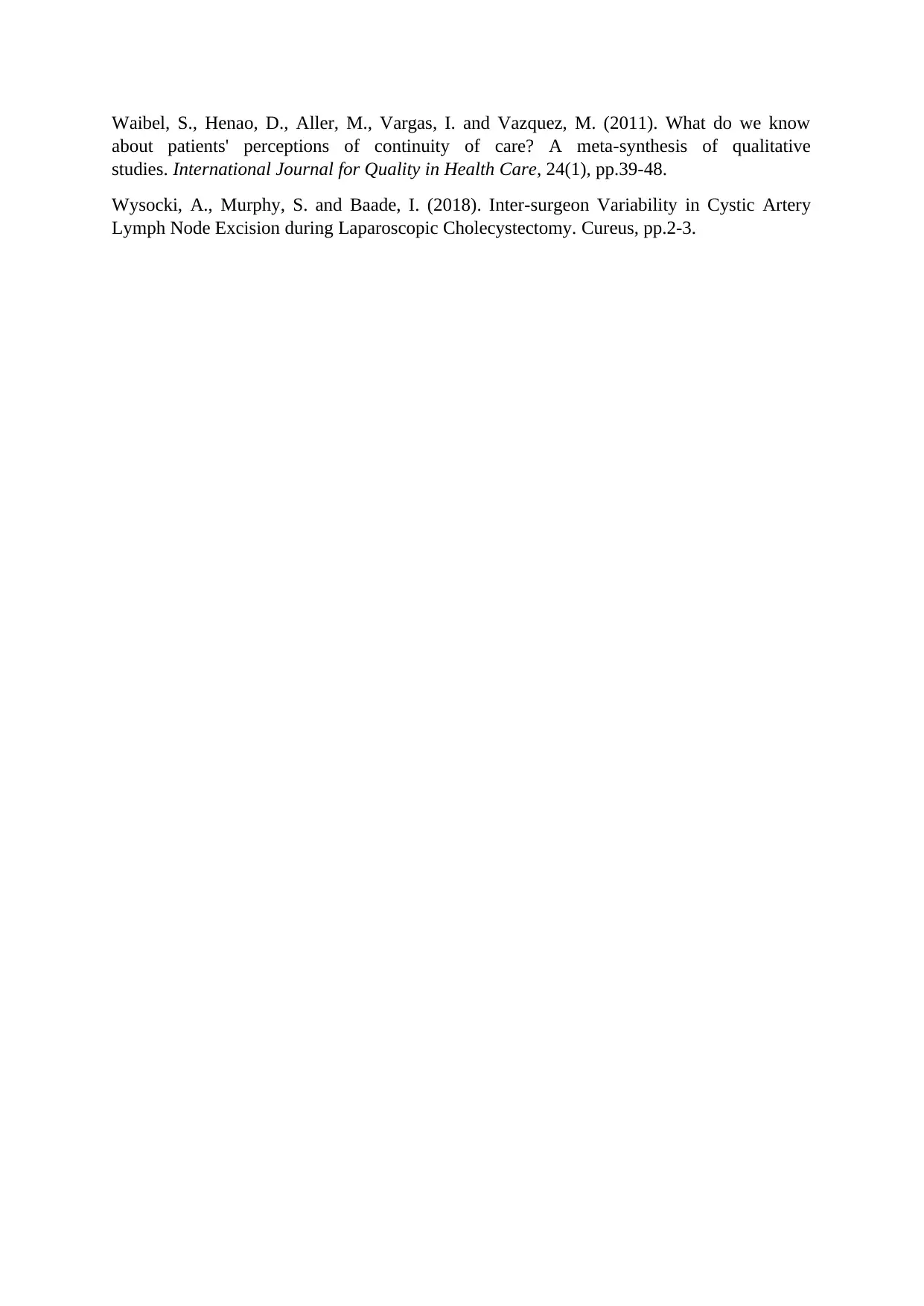
Waibel, S., Henao, D., Aller, M., Vargas, I. and Vazquez, M. (2011). What do we know
about patients' perceptions of continuity of care? A meta-synthesis of qualitative
studies. International Journal for Quality in Health Care, 24(1), pp.39-48.
Wysocki, A., Murphy, S. and Baade, I. (2018). Inter-surgeon Variability in Cystic Artery
Lymph Node Excision during Laparoscopic Cholecystectomy. Cureus, pp.2-3.
about patients' perceptions of continuity of care? A meta-synthesis of qualitative
studies. International Journal for Quality in Health Care, 24(1), pp.39-48.
Wysocki, A., Murphy, S. and Baade, I. (2018). Inter-surgeon Variability in Cystic Artery
Lymph Node Excision during Laparoscopic Cholecystectomy. Cureus, pp.2-3.
1 out of 8
Related Documents
Your All-in-One AI-Powered Toolkit for Academic Success.
+13062052269
info@desklib.com
Available 24*7 on WhatsApp / Email
![[object Object]](/_next/static/media/star-bottom.7253800d.svg)
Unlock your academic potential
Copyright © 2020–2025 A2Z Services. All Rights Reserved. Developed and managed by ZUCOL.




